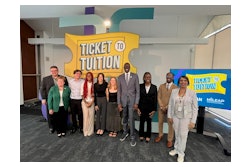WASHINGTON
When Ricardo Esparza became principal of Granger High School in South Central Washington state nine years ago, he walked into an environment where gangs roamed the halls, fights were common and academic performance was less than impressive.
“We had a 30 percent graduation rate about five or six years ago and 20 percent passing in reading (on the Washington Assessment of Student Learning) and 8 percent in writing,” Esparza said. “It (the school) was definitely demoralized.”
In the past three years, academic and social improvements made at Granger have started to take root. In 2007, the school — which is about 86 percent Latino, with 92 percent of students enrolled in the federal free- and reduced-price lunch program — posted a 90 percent graduation rate, Esparza said.
Asked to grade his school today in terms of academic rigor and student support, Nick Guerra, a junior at Granger, gave it a “B+” noting that “We’ve come a long ways. We’ve probably been an “F” at one time, but we’ve shown a lot of progress over the years.”
Granger was one of several schools across the country with high-minority and high-poverty enrollments that have been labeled a success because of factors highlighted recently during a three-day conference on high school equity held in Washington, D.C.
About 40 Latino local and state elected and appointed officials from states such as Arizona, Maryland, New York and Michigan attended the conference, sponsored by the National Association of Latino Elected and Appointed Officials Educational Fund, also known as NALEO.
Conference attendees heard Esparza, Guerra and fellow Granger student Lee Sekaquaptewa talk about educational programs and approaches that work, as well as about what students need from their high schools.
The conference is part of a larger national campaign to promote educational equality in American high schools. It represents a historic collaboration among several minority-focused organizations, including the NAACP, the National Council of La Raza and the National Urban League, to educate legislators and citizens in addressing the poor instructional quality and low student achievement of minority and low-income students in the nation’s high schools.
Conference participants created strategies to improve educational outcomes in their localities and received expert advice on communicating the urgency of the issue “to their constituents and their community, to get them to be mobilized,” said Eric Wagner, media manager for NALEO.
The campaign reflects the reality that various minority groups in this country “all have common needs, we all have common goals and this has to be done for all of our students,” Wagner said.
Kati Haycock, president of The Education Trust, a non-profit organization that promotes high academic standards for low-come and minority students, outlined at the conference the many disparities in funding, teacher quality, student expectations and graduation rates that exist between high-income, low-minority schools and their low-income, predominately minority counterparts.
The most recent data from the organization shows that an average gap of $938 in funding per student exists between high-poverty and low-poverty school districts, while high-minority school districts receive about $877 less per student than low-minority ones.
Haycock pointed out that poor Latino, Black and American Indian students are less likely to be taught by qualified teachers, less likely to be enrolled in a college-preparatory curriculum and more likely to receive assignments that pacify, rather than stimulate them intellectually.
“Kids who have three strong teachers in a row will soar,” Haycock said. “Kids who have three weak teachers in a row never recover.”
The most powerful actions that so-called “good schools” take to benefit their minority students who come from high-poverty neighborhoods involve attracting the best teachers, placing them in classrooms where students need the most help and “chasing out the teachers who are not good enough for their kids,” Haycock said.
Good schools also:
*Focus on their students’ potential to learn, rather than their socio-economic status;
*Provide their teachers with clear goals for instruction and a strong curriculum to meet them;
*Assess students regularly and intervene quickly to tackle academic problems; and
*Set high expectations for their students, which includes enrolling all of them in advanced courses and preparing everyone for college and employment
Sekaquaptewa, a junior at Granger, credited the school’s mentoring, academic advising services and the efforts of lead counselor, Greg Herrera, in helping him stay on track to become a high school band teacher.
Click here to post and read comments
© Copyright 2005 by DiverseEducation.com


















